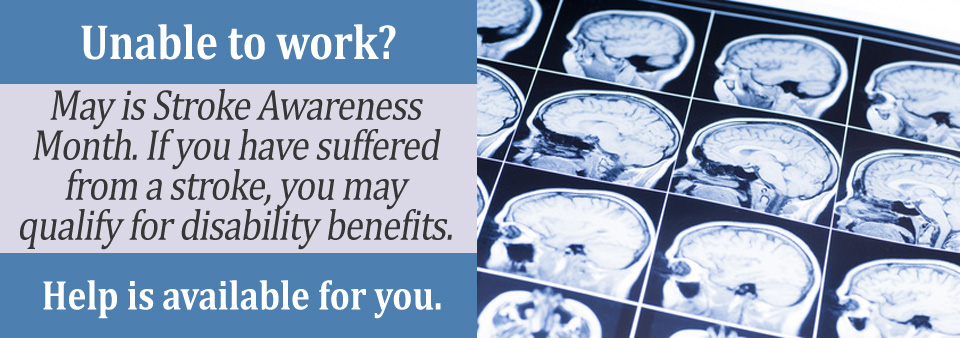Each year over 133,000 Americans die as a result of a stroke injury. What makes this number so devastating is that the vast majority of strokes are preventable. Strokes are the leading cause of disability in the United States.
Depending on the type and severity, it’s entirely possible that individuals who have experienced a stroke are no longer able to work. If this is the case for you, you may qualify for Social Security Disability benefits from the Social Security Administration (SSA).
Why an Awareness Month for Strokes?
Every 40 seconds in the United States, someone has a stroke, impacting 795,000 people each year. While these “brain attacks” can certainly be deadly, knowing the signs and symptoms can save lives, as well as decrease the long-term effects of a stroke.
According to the American Stroke Association, only 8 percent of individuals can identify the most common stroke signs: Facial drooping, Arm Weakness, and Speech Difficulty. As time is of the essence in stroke care, fast identification of symptoms is crucial.
More, many risk factors for stroke are modifiable. For example, high blood pressure is one of the leading causes of stroke, and yet many people do not get their blood pressure checked on a regular basis. Other modifiable factors include cholesterol levels, smoking, obesity, and diet.

How Can Someone Who Has Had a Stroke Qualify for Social Security Disability Benefits?
To determine if your stroke is disabling enough to earn benefits, the SSA will first consult their medical guide of impairments, also known as the Blue Book. A stroke is listed in section 11.04, vascular insult to the brain, of the Blue Book.
As a stroke can impact several body systems, it is possible that you might meet a separate Blue Book listing as well. For example, if your stroke has resulted in visual disturbances, you might be evaluated under section, 2.00, special senses.
To qualify for disability benefits for your stroke you must experience one of the following criteria:
- Ineffective speech or communication that has persisted for at least three months
- Difficulty in motor function of at least two extremities that makes it difficult to go from a seated to standing position, balance while standing or walking, or using the upper extremities.
- A decline in mental functioning that results in trouble concentrating, persisting on a project, understanding or remembering information, interacting with others, or managing oneself.
What If I Don’t Meet or Match a Blue Book Listing for My Stroke?
While a stroke might leave you disabled, you might not meet or match a Blue Book listing for the impairment. If this is the case, you might still qualify for disability utilizing a medical-vocational allowance.
Many individuals who have had a stroke are left with many functional limitations. A Social Security Reviewer will review your medical record and evaluate your residual functional capacity (RFC) to determine what type of work, if any, that you are still capable of performing since your vascular insult.
Individuals who have had a stroke may have difficulty walking, standing, using their hands, speaking, or communicating. Any of these difficulties could make it impossible for you to perform well in your job. Once your RFC is determined, the SSA will utilize the grid rules to determine the level of work that you can perform. Your age, experience, and acquired skills will all come into consideration when determining your disability eligibility.
How Do I Start the Disability Application Process for a Stroke?
Individuals who have had a stroke should contact an experienced Social Security Attorney or Disability advocate. The SSDI application process is complex and requires an abundance of medical evidence. The earlier that you obtain legal assistance for your disability claim, the more likely that it is that you will earn benefits for your stroke injury.